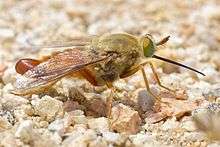Rhaphiomidas
The mydid fly genus Rhaphiomidas contains fewer than 30 species/subspecies, all of them occurring in the desert regions of the southwestern United States and adjacent portions of northwestern Mexico. The adults are most commonly encountered in sand dune areas, and are typically only active for a few weeks each year, either in the spring or the fall; in some cases, more than one species can occur in the same dune system, but they are allochronic, each flying in different seasons. Almost nothing is known about their biology, though eggs or early instar larvae of some species are laid on the soil surface and appear to be attractive to ants, and are brought into the ant nest (it therefore seems likely that the larvae are predators of the ant brood). The restriction to sand dune areas has unfortunately led a number of these flies to the brink of extinction, especially both subspecies of R. terminatus, and the species R. trochilus. While there is only one of these on the Endangered Species List (Rhaphiomidas terminatus abdominalis, a.k.a. the "Delhi Sands Flower-loving fly"), many of the remaining taxa - including a few that have not yet been named - are gravely imperiled, as they are restricted to small geographic areas (less than 500 square miles (1,300 km2), sometimes much less), rendering them extremely vulnerable to habitat loss or disturbance. These habitats are heavily targeted for development, and even if not, activities such as sand mining or motorized off-roading are common, and render the habitat unsuitable for the survival of the flies.
| Rhaphiomidas | |
|---|---|
 | |
| A male of Rhaphiomidas acton maehleri | |
| Scientific classification | |
| Kingdom: | Animalia |
| Phylum: | Arthropoda |
| Class: | Insecta |
| Order: | Diptera |
| Family: | Mydidae |
| Subfamily: | Rhapiomidinae |
| Genus: | Rhaphiomidas Osten Sacken, 1877 |
| Species | |
|
Several (see text) | |
| Synonyms | |
|
Apomidas Coquillett, 1892 | |
The family affiliation of the genus has changed fairly recently, as it had been previously placed in the family Apioceridae, or "flower-loving flies" - but, despite the transfer, the name "flower-loving flies" is nonetheless still used to refer to various species of Rhaphiomidas.
Species
These 28 species belong to the genus Rhaphiomidas.[1][2]
- R. abdominalis Cazier, 1941
- R. acton Coquillett, 1891
- R. aitkeni Cazier, 1941
- R. auratus Cazier, 1986
- R. ballmeri Van Dam, 2010
- R. brevirostris Cazier, 1954
- R. episcopus Osten Sacken, 1877
- R. forficatus Cazier, 1985[3]
- R. hasbroucki Cazier, 1986
- R. hirsuticaudus Cazier, 1986
- R. hoguei Rogers, 1993
- R. maculatus Cazier, 1941
- R. maehleri Cazier, 1941
- R. michelbacheri Cazier, 1985[3]
- R. moapa Rogers & Van Dam, 2007
- R. nigricaudis Cazier, 1986
- R. pachyrhynchus Rogers & Van Dam, 2007
- R. painteri Cazier, 1941
- R. parkeri Cazier, 1941
- R. scopaflexus Rogers, 1993
- R. socorroae Cazier, 1985[3]
- R. spinicaudus Cazier, 1985[3]
- R. tarsalis Cazier, 1986
- R. terminatus Cazier, 1941 (flower-loving fly)
- R. trochilus (Coquillett, 1892)
- R. undulatus Cazier, 1986
- R. vittatus Cazier, 1985[3]
- R. xanthos Townsend, 1895
References
- "Rhaphiomidas Report". Integrated Taxonomic Information System. Retrieved 2018-03-04.
- "Browse Rhaphiomidas". Catalogue of Life. Retrieved 2018-03-04.
- Cazier, Mont A. (1985). "A Revision of the North American Flies Belonging to the Genus Rhaphiomidas (Diptera, Apioceridae)" (PDF). Bulletin of the American Museum of Natural History. 182 (2): 181–263. ISSN 0003-0090. Retrieved 2 December 2018.
Further reading
- Arnett, Ross H. Jr. (2000). American Insects: A Handbook of the Insects of America North of Mexico. 2nd Edition. CRC Press. ISBN 0-8493-0212-9.
- Charles, H. Curran (1934). "The families and genera of North American Diptera". doi:10.5962/bhl.title.6825. Cite journal requires
|journal=(help) - McAlpine, J.F.; Petersen, B.V.; Shewell, G.E.; Teskey, H.J.; et al. (1987). Manual of Nearctic Diptera. Research Branch Agriculture Canada. ISBN 978-0660121253.
External links
- Dikow, Torsten (2018). "Asiloid Flies, deciphering their diversity and evolutionary history". National Museum of Natural History of the Smithsonian Institution. Retrieved 2018-03-04.
- "Diptera.info". Retrieved 2018-03-04.
